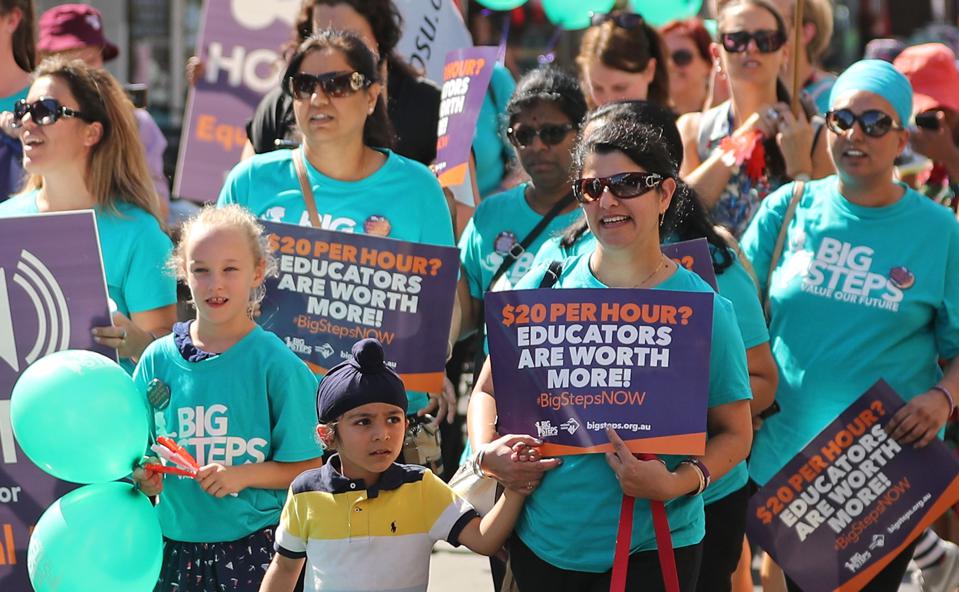#WomenEd Blogs
Increasing female participation in educational leadership: why we should and how we can.
by Imogen Senior @MrsSeniorStBens1
When I offered to speak at the #WomenEdEastern unconference on 23rd September, 2021, I hoped that I had something to offer. I have been a headteacher of a secondary school of 900 students for over two years and have been teaching for 20 years. I have three children (now aged 13, 10 and 5). I worked part-time for 18 months after my third child, returned to work full-time after four months after my second child and applied for, interviewed for, and was appointed to my first senior leadership post whilst 36 weeks pregnant (also with my second).
I have worked in various leadership roles in different schools and as a headteacher I have interviewed and appointed staff at all levels. I have a degree in History, an MA in Religious History, a PGCE, a PCert and an MA in Catholic School Leadership. My most recent dissertation focused on barriers to female leadership in mixed gender Catholic Schools and as part of this research I interviewed six female school leaders about their experiences. Next month I start a PhD where my research will focus on the 'formation' of female headteachers of mixed gender Catholic schools.
I have been following #WomenEd for some time and I wrote a chapter for the second WomenEd book Being 10% braver: Slaying the dragon of imposter syndrome. I believe that female participation in educational leadership matters and I hope I can communicate some of my experience.
Female participation matters because it is unjust that there continues to be a significant gender imbalance between the educational workforce and the leaders of that workforce. The 2020 National Office of Statistics data indicates that 75% of classroom teachers are female, but only 67% of Headteachers are female, that gap however shows a huge variance across the sector. According to TES 2019 data, in Secondary schools 63% of the teaching staff are female but they make up fewer than 38% of Headteachers. In primary schools whilst only 14% of the teaching staff are male, 27% of primary Heads are men. This difference is stark and the data does not begin to analyse the anecdotal experience of women in schools, where middle leadership and senior leadership roles too often are disproportionately filled by men. If, as educators we want to promote to our students and the young people that we work with that they should be ambitious and seek to challenge inequality, we need to address the injustice within our own sector where the majority female workforce is led by a disproportionate number of men. This is why the work of #WomenEd is so important in challenging this status quo.
As well as being unjust, the imbalance of the workforce furthers financial inequality. According to the TUC, the gender pay gap in the education sector is 25.9% and according to the NEU 2018 data, the average female headteacher earns £5,700 less than her male counterpart and those inequalities increase with age.
An average female headteacher over 60 earns £13,500 per annum less than the average male headteacher in the same age bracket.
This financial inequality is likely to be caused by a wide range of factors including the likelihood of women taking career breaks or maternity leave. However whilst this persists, families can face stark decisions about who should take a career break or reduce their hours. This means that when women are already earning less, the cycle becomes even more entrenched.
There is also a practical reason to increase female leadership within schools. There remains a crisis in headteacher and school leader recruitment and if we want our schools to have well-qualified, experienced and capable leaders we need to ensure that those who possess the potential to be those leaders are not prevented from growing in to those roles by barriers that can and should be addressed.
There is a legal driver behind the need to increase participation in school leadership. Legally employers need to ensure that they do not discriminate either on the basis of gender or any other protected characteristic and that their recruitment practices and principles support them in this. Despite the legal burden on employers, 80% of women believe that gender discrimination exists in the workplace (HR accreditation body 2018).
We need to do more to ensure that neither overt or covert discrimination is accepted in schools and that both biases in our systems are challenged.
Finally, participation matters for both women and all protected groups because we need diverse role models in society. Again, if our role as educators is to inspire and encourage young people, we need to ensure that those young people see diverse role models in their lives. We need to ensure that we are socialising girls to be future leaders and actively encouraging those traits that will enable them to be leaders of the future through modelling those behaviours. A 2015 study of over 3,000 women conducted by IPSOS for KMPG showed that 86% of participants could remember being taught to be ‘nice’ as a child, only 44% felts that they had been taught to be a leader and only 34% that they were taught to share their point of view.
If we want women to participate in the future, we need to provide role models of that leadership within our community.
My own experience as an emerging leader was muddled and lacked clarity. As an early Fast Track teacher, I was encouraged to develop my leadership skills. I attended courses looking at the differences between leadership and management and on ‘dealing with challenging conversations’. On reflection now, I think that most of what was discussed and modelled was still a very traditional style of leadership. The models were usually discussed as ‘hierarchical’ or ‘distributed’ (with preference given for a ‘distributed’ approach), but in reality these models were almost always ‘transactional’, built around structures and roles rather than people and visions. I began to feel that I did not have the skills or approach that I would need to become a Headteacher. I found those approaches unnatural and difficult to adopt. I worked with some amazing leaders and whilst I continued to be successful in the middle and then senior leadership roles that I fulfilled, I compared myself directly with others and felt that I lacked the ‘drive’ to be the kind of leader that I felt it was required to be. Gradually, I recognised that the way in which I had done things had been successful and that perhaps I did not need to swap out what had worked for me. I began to see that maybe there were different ways in which one could be a successful Headteacher.
Through studying for my MA in Catholic School Leadership I deepened my understanding of other approaches. Underpinned by the principles of servant leadership (Greenleaf 1973, Punnachet, 2009) I realised that for me as a leader, I wanted my approach to be ‘invitational’. There are times though where this approach is not right and on a ‘situational’ basis, I might need to be more directive but that these are legitimate approaches. Crucially I realised that what mattered to me as a leader was that my leadership is authentic, that I act as I believe is right rather than seek to do what ‘a headteacher’ would do. I realised that it is perfectly reasonable to be a leader who follows their own path and I think it is important, particularly for women to recognise that they can be leaders on their own terms.
I believe that it is important to have diversity in leadership and in our approaches to leadership. Not all women have found the debate around potential inherent differences between male and female leadership helpful. In 2017 Hedlin (p.239) found in her study of Swedish leaders that often women sought to distance themselves from these conversations as this potentially de-legitimised their achievements, by suggesting that they were ‘different’ from male colleagues. The debate however around gendered approaches to leadership is long-standing. In 1989 Shakeshaft (p.329) pointed out that societal practices and the reality of experience itself influences interactions and that therefore relationships between a female leader and male colleague are different ‘not by design but context’. In short, female leaders bring with them a weight of expectation that male colleagues are unlikely to experience. In my own research, several of my participants felt that their approach to many areas, and particularly their approach to dealing with confrontation was different from male colleagues by necessity.

Their experience and my own was that as a woman I had relied throughout my career on being able to diffuse confrontation where a male colleague might have sought to assert their dominance as a way out. (At 5ft 2, even in my big shoes ‘presence’ has to be about more than physical posturing for me!) Again, I and my several participants in my research felt that our skills as diffusers, empathetic listeners, negotiators and collaborators had been honed by practise and necessity rather than being instinctive. Akudi and Okenwa’s 2015 study in Nigeria suggested to them that ‘women seem to possess unique abilities’ that men do not (Akudi & Okenwa, 2015 P.1). Coleman’s 2005 study for the NCSL also stated that 50% of female secondary headteachers felt that their gender had been and advantage in their role whereas only 22% of men said the same (Coleman, 20015, p.33). Whether any differences are learned or innate is impossible to assess, but differences have frequently been observed. In terms of how leadership is shaped, it could be argued that the approaches women often commonly use make them more successful leaders. Eagly, Johanesen-Schmidt and Van Engen’s 2003 (p.457) meta-analysis of 45 separate studies suggested that women most frequently use the transformational styles and approaches to leadership that have been identified as the ‘most recommended’ approaches.
Despite all this suggestion of success, what I find interesting here is that whilst these are the approaches women often display, it seems that there is greater scrutiny of female leaders. One of the participants in my study referred to this as an unequal ‘right to failure’. Carli’s 2001 study suggested that there was greater scrutiny of female leadership behaviours. In my study, the experience of several participants was that where male colleagues showed an empathetic approach or even a range of approaches this was seen as a strength whereas in women it was considered as weakness and lack of consistency (Carli, 2001, p 726). Cliffe in 2015 described examples of individual women who felt that at certain times they adopted more ‘masculine leadership beahviours’ to reinforce their position and enhance their credibility (Cliffe, 2015, p.2781). It must be hoped however that if different approaches are consistently used by both men and women, in time this will support a greater diversity.
The importance here of #HeforShe and collaboration cannot be understated. There are very many male leaders in education modelling different models of leadership and who support female colleagues using non-traditional approaches to leadership. We should always seek to support the best applicants for posts and diversity should be championed.
Leadership in schools is about nurturing, supporting, and encouraging not just our students but all members of our community. It should also be about challenge and determination to seek a better world. Southworth’s 2002 work discusses how often in looking at school leadership we fail to address the importance of leadership throughout the school (p.74). Too often, the understanding of leadership centres around the headteacher and not those who in reality lead and manage throughout the school. In my view, this is one of the weaknesses of ‘distributed’ leadership. In my own school, I hope I promote an invitational approach where our vision and mission are clear and staff at all levels feel ‘invited’ to bring their unique talents and abilities to support that vision. There is still accountability and challenge, but this should be open and honest.
If we acknowledge that change is needed we need to look at how we bring about that change. Barsh and Cranston (2009, p.165) talk about the importance of the support of others and role models are key in modelling female leadership at all levels. It matters I think that we acknowledge and support one another and recognise the challenges that female leaders face. We have come a long way since 1973 when the ‘Queen Bee’ description of female leaders was first coined but Derks, Van Laar and Ellemers (2016) still found in their research that women leaders can often distance themselves from others as a way of protecting their hard-won status. Rather than giving a ‘hand up’ to female colleagues there can be a subconscious or even conscious bias against other women from female leaders expecting others to make the sacrifices they have made. These sacrifices are real. Coleman’s 2005 [ibid] study showed that 96% of male secondary headteachers were married and 90% were parents, the contrast was startling where only 78% of female secondary headteachers were married and 63% were parents. Women, for too long did make sacrifices and made choices that affected their personal lives and home lives in a way that men did not and it can be natural for some to feel resentment. As female leaders and potential female leaders we have to see equal validity in all those choices and circumstances. Married or single, mother or not (or any other personal situation) women should not be expected to make choices about what they can or cannot do that a male colleague would not be forced to make. We have to support one another in this where we can. Personally, I have been told by other women that: I am a ‘career woman’ rather than ‘prioritising family’ like them, that I am not raising my own children by sending them to nursery, I have been told not have any more children because my maternity leave was disruptive and had my maternity status declared in a reference. My husband, who is also a teacher, has never encountered any of these situations despite now working part time and acting as our children’s primary carer.
I am determined that I will champion all the decisions made by women that I would not question in men.
To affect real change, where we do not see role models in the organisations we work with, we should seek to connect and support one another when we do. We need to reassess what we advertise and interview for in leadership roles for example uncoupling discussions about the inherent need for challenge with an assumption of confrontation. We have to welcome different approaches to leadership where they are successful rather than drawing unhelpful comparisons between leaders and their individual styles and approaches.
My own experience as a headteacher so far has been one of reappraisal and #Being10percentBraver. When I first started in headship I often thought, ‘is that something a headteacher should do?’ I felt every action I took was scrutinised and that I needed to ‘act like a headteacher’. Suddenly everything about my appearance seemed to link to my credibility. Kruse and Spikard Prettyman (2008, p.457) describe how many female leaders cultivate a particular image which is a ‘carefully polished external persona’ as a sort of ‘insurance against potential negative evaluation’. The conversations I had with female leaders also talked about this and how much effort they put in to analysing their appearance as viewed by others as well as the appearance of their actions. I often questioned my own choices and how valid they were, not because I am questioned my judgment but because I worried about how my leadership was viewed by others. Ultimately, this is where an authentic approach to leadership really matters and I do things frequently to remind myself that I can and should be true to my own values.
Not long ago I ordered a dress with the intention that it was not for school wear. (It is a knee-length Cath Kidson dress with bunnies eating carrots on it.) There was nothing inappropriate about the style or cut of the dress for a professional environment, but it doesn’t shout ‘headteacher’ so I ordered it for weekend only wear. When the dress arrived in the post I really liked it and I tried it on, I felt smart, it looked nice and looked as if I had made an effort (my shoes match it and have coordinating accessories). It is very ‘me’. I wear the dress to school most weeks. I wear that dress because it reminds me that do not need to dress ‘like a headteacher’. I am a headteacher and if the only reason I am taken seriously is because of my clothes something has gone very, very wrong.
I want other women to find the confidence to wear their metaphorical (or real) bunny rabbit dress
When you subscribe to the blog, we will send you an e-mail when there are new updates on the site so you wouldn't miss them.


Comments